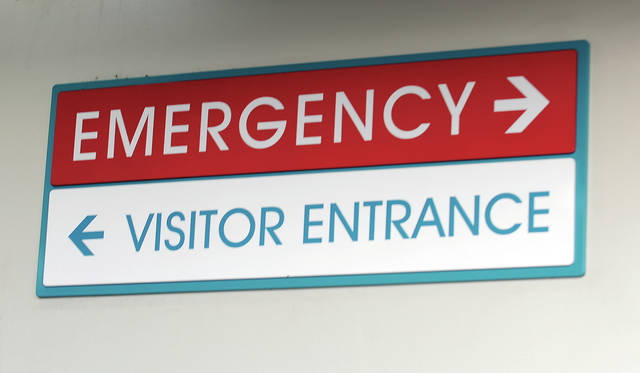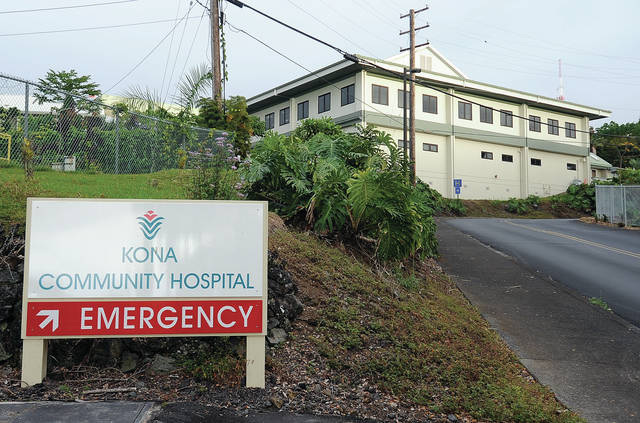Scabies outbreak hits Kona hospital



KAILUA-KONA — Over the last week, a scabies outbreak has run rampant through the ranks of Kona Community Hospital, sidelining several employees. And hospital officials say more cases are likely to appear.
KAILUA-KONA — Over the last week, a scabies outbreak has run rampant through the ranks of Kona Community Hospital, sidelining several employees. And hospital officials say more cases are likely to appear.
Lisa Downing, director of Infection Prevention and Employee Health at KCH, said the outbreak was officially identified on Nov. 19 after an “over abundance of people” complained of similar symptoms. As to the exact number of those infected, she remained non-committal.
“We’re still in the middle … of the outbreak, so it’s definitely not over yet,” Downing said. “I don’t have totals of numbers and probably won’t until at least six-eight weeks out.”
A source who works at KCH and who asked to remain anonymous because talking to the press is a violation of hospital policy initially contacted West Hawaii Today (WHT) about the outbreak. The source said that to date, more than 50 hospital employees have been diagnosed with scabies.
Judy Donovan, KCH regional director of marketing and strategic planning, said the hospital employs just over 450 personnel in total.
Downing would neither confirm nor deny that more than 50 employees had contracted scabies because the investigation remains ongoing. She did, however, indicate the number of cases is likely to rise from current levels as symptoms can take two to four weeks to appear, according to the Hawaii Department of Health Disease Outbreak Control Division website.
As to the number of patients infected since the identification of the outbreak, Downing also declined to comment, saying that to do so would risk KCH running afoul of privacy laws enacted under the Health Insurance Portability and Accountability Act (HIPAA).
The anonymous source said to their knowledge there has been no official confirmation of a patient contracting scabies due to the outbreak. They indicated that was because staff are typically careful in their interactions with patients not to spread or contract disease but the same precautions aren’t usually observed in staff-to-staff interactions.
As to the cause of the outbreak, Downing said there was no misdiagnosis. She declined to confirm if the infection originated with a patient or on what day it first appeared in the facility, again citing privacy concerns.
The anonymous source said information circulating among hospital staff points to the outbreak originating with a patient, likely before Nov. 19.
Downing and the source also differed on who or what ought to shoulder the blame for the outbreak.
“Typically, when you have something like this happen, it’s not just one thing, one person, one unit, one issue,” Downing said. “And I think that our facility does a great job making sure that our patients are safe. Even looking at all the information I have, there’s really no blame to go around.”
But Downing’s opinion isn’t universal.
“I think there was a (mistake) in communication and no one really knew what they had to do,” said the source, adding that hospital protocol in place wasn’t disseminated through the ranks quickly and clearly enough.
“I would say management failed.”
Threats and protocols
Scabies is a highly contagious parasitic infection but often easily treatable. It is caused by a mite that burrows into the skin where it lays its eggs. The primary symptom is an itchy rash that can appear on several areas across the body.
The infection is most commonly spread through direct, skin-to-skin contact, but can also be transmitted for short periods through contact with clothing, towels and bedding, according to the DOH.
Downing said the outbreak poses the greatest threat to immunocompromised patients who might be at risk for opportunistic infections. However, she added the hospital is “very concerned with everyone that’s in and out of the facility.”
Hospital policy is to remove any employee with an active case for treatment, holding that person out of the facility for a full 24 hours after treatment has begun.
According to the DOH, that’s generally adequate. Applying medicated cream to the infected areas only once often eradicates the mites, the website reads, although the itching may continue for days or weeks afterward. More serious cases may require multiple topical applications and/or oral medication.
Perhaps the greatest danger posed by the scabies outbreak so far are the staff shortages it’s caused. Downing didn’t mention a name, but said a specific department had significant staffing issues for a time last week.
“We had a little bit of a staffing issue in one of these departments, and it was actually handled very well,” Downing said. “So at no time did we have lack of staff or lack of qualified staff to take care of our patients, but we were a little strained in that one particular area.”
The anonymous source said the department Downing referred to was the intensive care unit, where the vast majority of staff had to rotate out for the 24-hour mandatory period at one point or another over the last seven days.
As to whether another department may be impacted similarly as the outbreak continues, Downing said she couldn’t comment with certainty.
“You hope that at this stage, things start to slow down instead of get worse and instead of that slow burn (continuing),” she said. “We are hopeful we’re not going to see another resurgence.”
Employees confirmed to have contracted scabies will be treated again within a week of their initial treatment as an extra safety measure, Downing added.
Since the outbreak was identified, beyond removing infected personnel, hospital policy has been to put patients who were potentially exposed into isolation, notify everyone for adequate coverage, evaluate patients for relocation or discharge in anticipation of possible future staff shortages, intensify housekeeping efforts and mobilize the pharmacy with an adequate amount of relevant medications.
Notification policies
KCH officials have to this point only circulated information to staff members, patients and patients’ families they believe may have been exposed to the infection.
“To notify every one of our patients when there is any kind of contagious disease when they come in, that’s not feasible. And frankly, scabies … it’s not life threatening,” Downing said. “We do not and are not going to notify patients coming in of that potential risk. We don’t do it for any other conditions either.”
KCH officials say the hospital has been in contact since Nov. 19 with its community partners, or essentially any facilities with which KCH shares patients, to make them aware of the potential concern.
As to notifying state authorities, DOH spokesperson Janice Okubo wrote in an email to WHT that hospitals aren’t required to report scabies outbreaks and that Hawaii’s Disease Investigation Branch doesn’t track the disease.
Downing said KCH reached out to the state at the start of the outbreak regardless of policy. However, a second email sent to WHT from the DOH indicates a potential miscommunication in this regard.
“After your notification, our DOH Disease Investigation Branch contacted our West Hawaii staff and they have reached out to the hospital to offer assistance if needed,” Okubo wrote to WHT on Monday.
Cause for concern?
As to whether potential patients should be afraid to set foot inside KCH in the coming weeks, every response was the same — no.
The anonymous source who brought the outbreak to light said they are comfortable attending work a week after it was initially identified.
“The community should actually feel absolutely safe coming here,” Donovan said. “There’s no reason to think this isn’t a safe place to come for treatment or care.”
Downing echoed those comments, saying this is the first incident of its kind in her decade at KCH.
“Our people do a really good job of following our protocols here,” she said. “Nothing like this has ever happened before, and I can pretty much guarantee you that everyone is going to be hyper vigilant from this point forward.”



This is HUGE and Outrageous! 10%+ of hospital employees have a transferable disease and they expect us to believe it is limited to the Hospital Staff? They refuse to give details? I understand patient privacy but this a small community hospital and they can not follow procedures amongst themselves and this is the result? What other issues have we as a community not been notified of or have had swept under the rug? This is our first line of defense as a community under emergency situations and healthcare and it is continually overlooked by our politicians. Longevity in this community depends on the quality and reliability of this facility and its staff. If our government is serious about taking care if its people this is where they should be looking first. They should look from birth to death and everything in between. Kim fails us as a human and is two faced. He should prioritize that medical facilities are properly staffed (yes recruitment and retainments) and property facilities to care for people. Native HAwaiians, Residents whom move here from other places and visitors alike! This is the very heart beat of our island and it’s existence and growth! People can not spend their lives here without knowing they can get real care. People will retire here if there is care and that helps drive the economy, people will not come if rumor has it there is poor emergency healthcare. Has anyone ever looked at the web site for the Healthcare facilities on Maui? It looks like something from the mainland. This island needs proper facilities in Hilo and Kona! This is not joke Politicians quit giving us the reach around and take care of the people that fill your retirement bags full of cash!
Yep,
the Hilo goberment folk “deserve” a raise
…good salary, good pension, good medical (not this scabies stuff)…
….and YOU get to pay for it!
This is HUGE and Outrageous! 10%+ of hospital employees have a transferable disease and they expect us to believe it is limited to the Hospital Staff? They refuse to give details? I understand patient privacy but this a small community hospital and they can not follow procedures amongst themselves and this is the result? What other issues have we as a community not been notified of or have had swept under the rug? This is our first line of defense as a community under emergency situations and healthcare and it is continually overlooked by our politicians. Longevity in this community depends on the quality and reliability of this facility and its staff. If our government is serious about taking care if its people this is where they should be looking first. They should look from birth to death and everything in between. Kim fails us as a human and is two faced. He should prioritize that medical facilities are properly staffed (yes recruitment and retainment of doctors and staff) and propet facilities to care for people. Native HAwaiians, Residents whom move here from other places and visitors alike! This is the very heart beat of our island and it’s existence and growth! People can not spend their lives here without knowing they can get real care. People will retire here if there is care and that helps drive the economy, people will raise families and stay on the island, people will not come if rumor has it there is poor emergency healthcare. Has anyone ever looked at the web site for the Healthcare facilities on Maui? It looks like something from the mainland. This island needs proper facilities in Hilo and Kona! This is not a joke Politicians quit giving us the reach around and take care of the people that fill your retirement bags full of cash!
Thank you “source.” Otherwise, how would the public know? Takes courage. I see nothing wrong with releasing the number of staff/patients affected because there are no names released. It’s no different than updating the public about the number of confirmed Zika, Hepatitis, or other outbreaks that occur. Hiding it does make it look worse than it is.
So, it is December 29th; which means it has been a little over a month since this outbreak. You have surgaries, blood tests, and the seting of broken bones happening all the time. Perhaps, you have more varibles. However, a condition caused by a burrowing mite and skin to skin contact with 200,000 cases (1 in 8 people, same as epilepsy) shold be detectable and have a textbook operation. If no one gets better Staff, Patients or Vistors. You, Hilo, and Strab or Kisser, Queens and Kapiolani better have a real meeting and come up with a way to eliminate this mite.